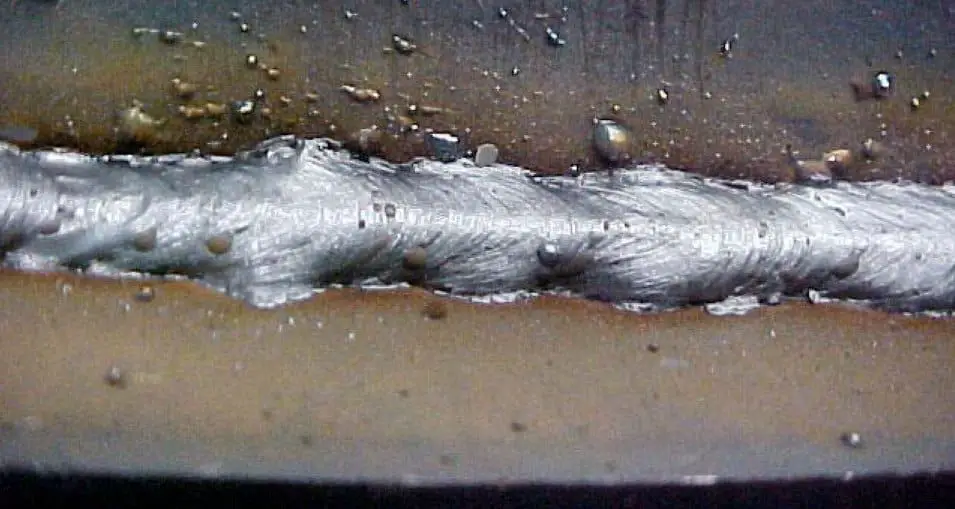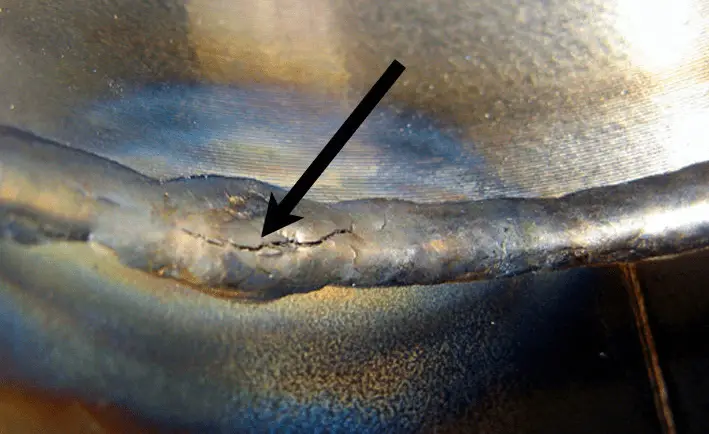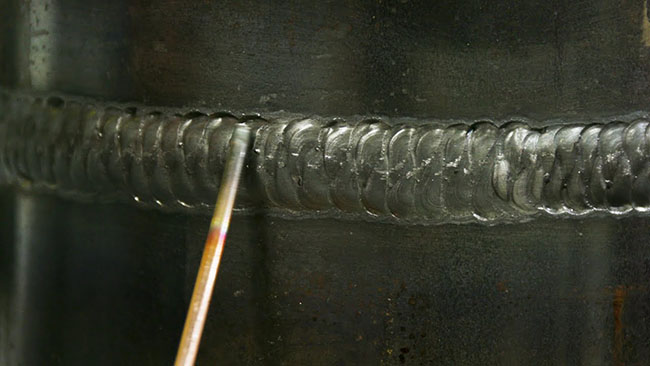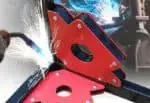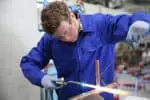Welding, like every other metalworking technique, is prone to errors. Given the complexities of the mechanisms involved in welding, a few errors are likely to happen.
Welding incorporates not just fire and metal surfaces, but also many other factors. Therefore, to prevent defects, many welding procedures were developed. Indeed, most of welding is about avoiding these defects, and the more experienced you are, the better the weld.
This article focuses on welding overlap, a prevalent problem that is readily avoided.
Overlap welding refers to the bulge of weld metal that extends beyond the root. The overlap is defined as a protrusion that extends beyond the weld toe. Although overlap is a weld discontinuity, it is still considered a defect. Overlap is most common in butt and fillet welds.
When there is an overlap, it signifies that the metal is not totally bonded. Generally, an overlap looks like a circle that extends into unneeded sections.
Why does this overlap happen?
Basically, an overlap happens after the weld pool overflows onto the weld metal surface. It happens when the molten metal does not fuse with the metal’s base, resulting in an overlap with an angle less than 90 degrees.
An overlap can arise due to a variety of reasons. Let us look at the various reasons-
1.) Excessive welding metal- One of the reasons why overlap happens is because of too much weld metal. Excess weld metal arises as a result of a slow weld pace, which causes the molten material’s gravity to produce overlapping in fillet welds.
2.) Incorrect Electrode Angle- Using an electrode at an incorrect angle also adds to overlapping. Because the electrode is exceedingly porous, employing it at the improper angle results in little more than overlap.
Furthermore, the presence of overlaps is caused by big electrodes. An electrode that is bigger than the metal size causes an overlap.
3.) Angle of the Electrode- Weld penetration and the amount of filler deposited on either side of the weld bead are affected by the electrode angle. As a result, if the angle is off, more filler enters on one side.
Overlapping is unavoidable in this instance. To avoid this, adjust the electrode angle to achieve equal filler material deposition.
4.) Electrode Dimensions- The amount of filler metal clearly determines whether or not overlapping occurs.
The filler is the electrode, and the larger the electrode, the more filler there is. If you detect an overlap, it might be caused by a big electrode.
Make sure you use the proper electrode size. You can either read the guides/charts or consult with an experienced welder.
5.) Excess Current Application, also known as Amperage- When too much electric current is used, it generates an overlap.
Too much current causes the weld material to overheat, resulting in an overflow above the metal. Excess current used during welding may result in instances of overlap.
Current, or amperage, is a crucial component in overlaps. If it is adjusted too high, a huge amount of filler material is deposited in the weld pool. If this amount is greater than what is necessary, it will naturally flow out and solidify somewhere else.
6.) Travel Pace- Overlap is also caused by slow travel speed. Because the filler deposition rate is constant throughout the weld, going too slowly will allow filler to collect in the weld pool and produce overlapping.
And how can you prevent this overlap?
The ultimate remedy to welding overlaps is correct welding technique. As is obvious, overlap arises as a result of preventable welding errors.
1.) Making Use of Small Electrodes
With big electrodes, there is a greater risk of applying too much weld material to the surface. It is best to use tiny electrodes to minimise overlapping.
This is because tiny electrodes lessen the gap by using less weld at each spot. Smaller electrodes reduce the possibility of surplus materials and overlaps.
2.) Improved Welding Techniques
Welding is a skill that everyone should learn. Slow welding, for example, leads to weld material overlap. You simply need to think about your welding speed to fix this. Also, how you position your materials is really important.
Depending on the welding procedure, suitable preparation and material selection are required.
3.) Welding Overlap Correction
Overlap is more of an excess disposition than a defect. Unlike other welding defects, a noticeable overlap may be repaired by grinding away the extra weld metal. Overlays are removed by smooth surface polishing at the metal’s base.
4.) Using the Appropriate Amount of Current
Depending on what you’re dealing with, you should adjust your current. The alternating or direct current levels should be appropriate for the work at hand.
A blazing or over-brightening electrode indicates that you are using too much current. The amperage: electrode diameter ratio should be 1:1000. This means that a quarter-inch diameter will require around 250 amps.
Apart from overlap, we might encounter some other defects in welding. Let’s find out what those are-
Welding defects are imperfections created in a particular weld metal as a result of an erroneous welding technique or faulty welding patterns. The flaw may differ from the expected form, size, and quality of the weld bead.
Welding defects can develop both outside and within the weld metal. Some faults may be acceptable if they are within permissible limits, while others, like cracks, are never accepted.
Welding defects are divided into two types: Exterior Defects and Interior Defects.
| External Defects | Interior Defects |
| Welding Crack
Undercut. Spattering Porousness. Duplication. Crater. |
Inclusion of slag.
Fusion that is incomplete. Cracked necklace. Incompletely filled groove or insufficient penetration |
Let’s look at External welding defects
1.) Cracked Weld
This is the most despised of all welding defects. Welding fractures can occur on the surface, within the weld material, or in the heat impacted zones.
Weld crack causes:
1. The supplied base metal’s ductility is poor.
2. The existence of residual tension on the weld metal might result in a crack.
3. The joint’s stiffness, which makes it difficult to expand or compress the metals.
4. Cracks may form if there is a high sulphur and carbon content.
5. Welding ferrous materials with hydrogen as a shielding gas.
2.) Spatter
It is a defect that occurs when certain metal droplets are released from a weld and remain attached to the surface.
Spatter causes-
1. This problem can be caused by a high welding current.
2. The greater the arc, the more likely this problem will occur.
3. Improper polarity.
4. Improper gas shielding may also contribute to this issue.
3.) Undercut
This sort of defect occurs when the base of the metal melts away from the weld zone, forming a groove in the shape of a notch. It decreases the joint’s fatigue strength.
Causes of undercut-
1. This problem may develop if the arc voltage is extremely high.
2. If we utilise the incorrect electrode or if the angle of the electrode is incorrect, a fault may emerge.
3. It is also not advised to use a big electrode.
4. One of the causes of this issue is likewise high electrode speed.
4.) Crater
It happens when the crater is not filled before the arc is broken, causing the crater’s outside edges to cool quicker than the crater itself. This creates stress, which leads to the formation of a fracture.
Causes of crater-
1. Improper torch angle.
2. Application of a big electrode:
3. Inadequate welding method
5.) Porosity
Porosity is a situation in which gas or tiny bubbles become trapped in the welded zone.
Causes of porosity-
1. It happens when the electrode is not adequately coated.
2. Using a longer arc may improve your odds.
3. Boosted welding currents
4. The presence of rust or oil on the welding surface.
Internal welding defects
1.) Inclusion of slag
Slag in the weld has an effect on the toughness and metal weldability of the provided material. This reduces the weld material’s structural performance. Slag forms on the weld’s surface or between the welding turns.
Causes of slag-
1. Slag is created when the welding current density is very low, since it does not give enough heat to melt the metal surface.
2. Slag may form if the welding speed is too rapid.
3. Slag may occur if the weld surface’s edge is not adequately cleaned.
4. Incorrect welding angle and welding rod travel rate.
2.) Necklace Fracture
It happens while using electron beam welding when the weld does not penetrate adequately. As a result, the molten metal does not flow into the hollow, resulting in a necklace cracking defect.
Causes of necklace fracture-
1. Inadequate welding method.
2. It may be found in nickel base alloys, stainless steel, carbon steels, and tin alloys.
3. Using a high-speed electron beam welder
3.) Incompletely Filled Groove or Incomplete Penetration
These flaws arise exclusively in butt welds where the metal groove is not completely filled. It’s also known as an incomplete penetration fault.
Causes of incompletely filled groove-
1. Less weld metal deposition
2. Using an electrode of the incorrect size
3. Inadequate welding method
4.) Incomplete fusion
It happens when the welder does not precisely fuse the material and the metal pre-hardens, resulting in a gap that is not filled with the molten metal.
Causes of incomplete fusion-
1. It happens as a result of the low heat input.
2. When the weld pool is huge and extends beyond the arc.
3. When the joint’s angle is too small.
4. Improper electrode and torch angle might potentially result in partial fusion.
5. Incorrect bead placement.
Conclusion
Welding overlap is a typical flaw produced by a variety of sources. However, with a little care and practice, you can achieve flawless welds.
Make sure you understand the welding techniques/procedures for the weld in question. It is critical to use as much accuracy as possible while welding. You may work your way out of welding overlaps by following the correct welding process.
If overlap does develop, it is usually possible to remove it by gently grinding to prevent injuring the joint.

